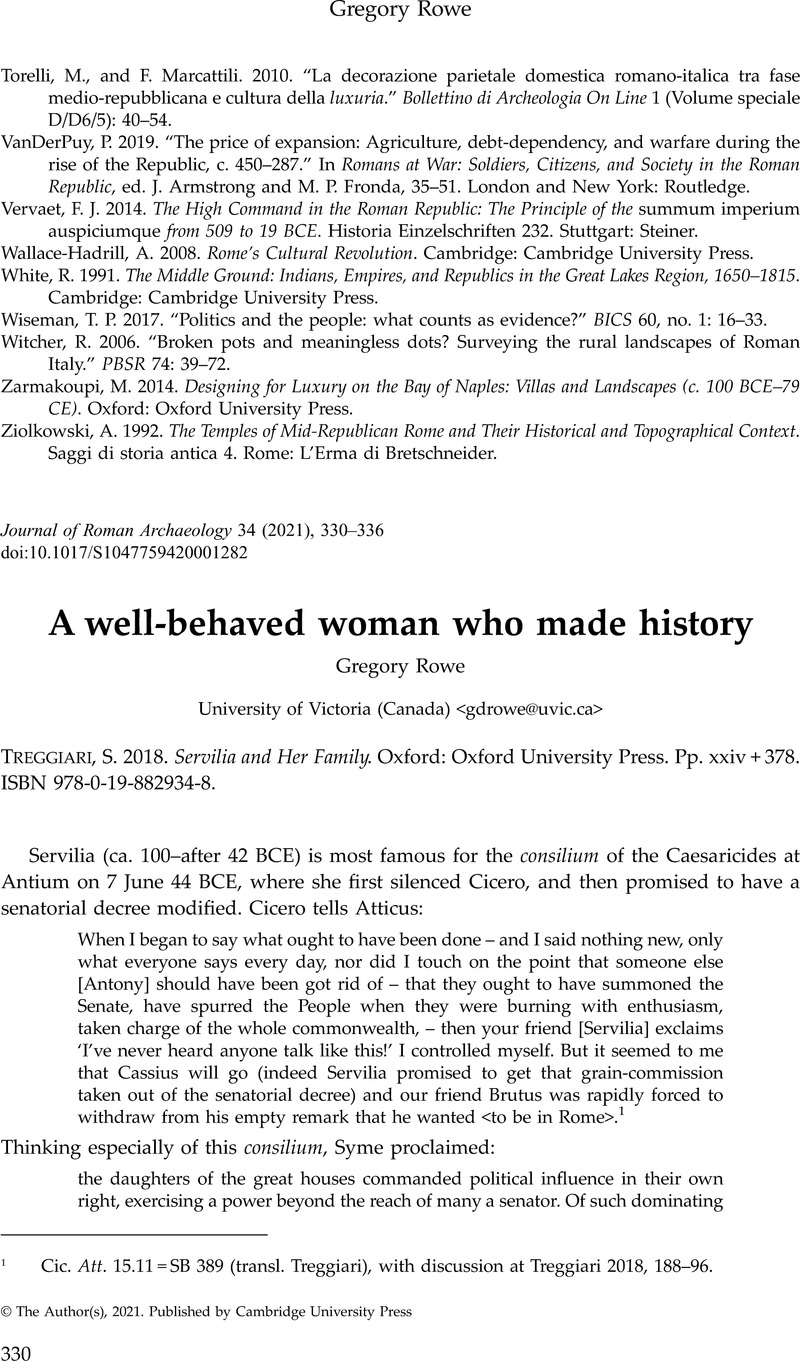No CrossRef data available.
Article contents
A well-behaved woman who made history - S. Treggiari 2018. Servilia and Her Family. Oxford: Oxford University Press. Pp. xxiv + 378. ISBN 978-0-19-882934-8.
Review products
S. Treggiari 2018. Servilia and Her Family. Oxford: Oxford University Press. Pp. xxiv + 378. ISBN 978-0-19-882934-8.
Published online by Cambridge University Press: 06 April 2021
Abstract
An abstract is not available for this content so a preview has been provided. Please use the Get access link above for information on how to access this content.

- Type
- Book Review
- Information
- Copyright
- Copyright © The Author(s), 2021. Published by Cambridge University Press
References
Borrello, S. 2016. “Prudentissima et diligentissima femina: Servilia, M. Bruti mater, tra Cesariani e Cesaricidi.” In Matronae in domo et in re publica agentes. Spazi e occasioni dell'azione femminile nel mondo romano tra tarda repubblica e primo impero, ed. Cenerini, F. and Rohr Vio, F., 165–91. Trieste: Edizioni Università di Trieste.Google Scholar
Brennan, T. C. 2015. “Perceptions of women's power in the late Republic: Terentia, Fulvia, and the generation of 63 BCE.” In A Companion to Women in the Ancient World, ed. James, S. L. and Dillon, S., 354–66. West Sussex: Blackwell Publishing.Google Scholar
Flower, H. I. 2018. “Servilia's Consilium: Rhetoric and politics in a family setting.” In Institutions and Ideology in Republican Rome: Speech, Audience and Decision, ed. van der Blom, H., Gray, C., and Steel, C., 252–64. Cambridge: Cambridge University Press.Google Scholar
Hillard, T. W. 1992. “On the stage, behind the curtain: Images of politically active women in the late Roman Republic.” In Stereotypes of Women in Power: Historical Perspectives and Revisionist Views, ed. Garlick, B., Dixon, S., and Allen, P., 37–64. New York: Greenwood Press.Google Scholar
MacMullen, R. 2019. “Review of Susan Treggiari, Servilia and Her Family.” BMCR, March 7. https://bmcr.brynmawr.edu/2019/2019.03.07/.Google Scholar
Manne, K. 2017. Down Girl: The Logic of Misogyny. New York: Oxford University Press.CrossRefGoogle Scholar
Morrell, K. 2017. Pompey, Cato, and the Governance of the Roman Empire. Oxford: Oxford University Press.CrossRefGoogle Scholar
Münzer, F. 1999. Roman Aristocratic Parties and Families. Translated by Ridley, T.. Baltimore: Johns Hopkins University Press, 1999. (Originally published as Römische Adelsparteien und Adelsfamilien [1920].)Google Scholar
Treggiari, S. M. 1993. Roman Marriage: Iusti coniuges from the Time of Cicero to the Time of Ulpian. Oxford: Clarendon Press.Google Scholar
Webb, L. In press. “Female interventions in politics in the libera res publica: Structures and practices.” In Taking the Lead in Late Republican and Early Imperial Rome: Office, Agency, and Initiative, ed. Burden-Strevens, C. and Frolov, R.. Leiden and Boston: Brill.Google Scholar




